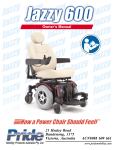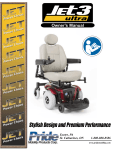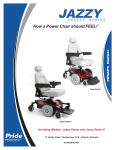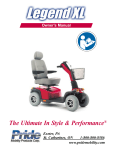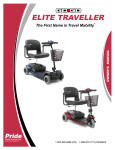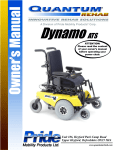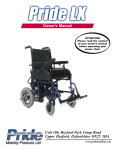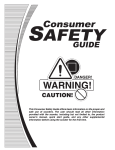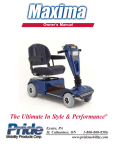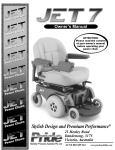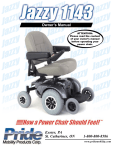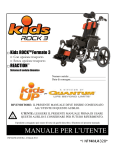Download Quantum 1650 - Pride Mobility Products
Transcript
Owners Manual 21 Healey Road, Dandenong, 3175, Victoria Australia www.quantumrehab.com ACN# 088 609 661 SAFETY GUIDELINES The symbols below are used throughout this owner's manual and on the power chair to identify warnings and important information. It is very important for you to read them and understand them completely. WARNING! Failure to follow designated procedures can cause either personal injury, component damage, or malfunction (black symbol on yellow triangle with black border). MANDATORY! These actions should be performed as specified. Failure to perform mandatory actions can cause injury to personnel and/or damage to equipment (white symbol on blue dot with white border). PROHIBITED! These actions should be prohibited. These actions should not be performed at any time or in any circumstances. Performing a prohibited action can cause injury to personnel and/ or damage to equipment (black symbol with red circle and red slash). NOTE: Supplemental information that may be helpful to operate the equipment. 088 609 661 Copyright © 2004 Pride Mobility Products Corp. INFMANU2544 2 www.pridemobility.com Quantum 1650/RevA/Jan04 TABLE OF CONTENTS I. INTRODUCTION................................................................................................................................. 4 II. SAFETY ................................................................................................................................................. 5 III. THE QUANTUM 1650.................................................................................................................... 14 IV. ASSEMBLY......................................................................................................................................... 20 V. COMFORT ADJUSTMENTS........................................................................................................ 21 VI. BATTERIES AND CHARGING .................................................................................................... 25 VII. OPERATION ....................................................................................................................................... 28 VIII. CARE AND MAINTENANCE ........................................................................................................ 31 IX. OPTIONAL ACCESSORIES ......................................................................................................... 37 X. WARRANTY........................................................................................................................................ 39 This owners manual is compiled from the latest specifications and product information available at the time of publication. We reserve the right to make changes as they become necessary. Any changes to our products may cause slight variations between the illustrations and explanations in this manual and the product you have purchased. Quantum 1650/RevA/Jan04 www.pridemobility.com 3 I. INTRODUCTION SAFETY WELCOME to Pride Mobility Products Australia Pty. Ltd. (Pride). The power chair you have purchased combines stateof-the-art components with safety, comfort, and styling in mind. We are confident that these design features will provide you with the conveniences you expect during your daily activities. Once you understand how to safely operate and care for your power chair, it should give you years of trouble free operation and service. Read and follow all instructions, warnings, and notes in this manual before attempting to operate your power chair for the first time. In addition, your safety depends upon you, as well as your provider, caretaker, or healthcare professional in using good judgement. If there is any information in this manual which you do not understand, or if you require additional assistance for setup or operation, please contact your Quantum Rehab Specialist. Failure to follow the instructions in this manual and those located on your power chair can lead to personal injury and/or damage to the power chair, including voiding the warranty. PURCHASERS AGREEMENT By accepting delivery of this product, you promise that you will not change, alter, or modify this product or remove or render inoperable or unsafe any guards, shields, or other safety features of this product; fail, refuse, or neglect to install any retrofits kits from time to time provided by Pride to enhance or preserve the safe use of this product. INFORMATION EXCHANGE We want to hear your questions, comments, and suggestions about this manual. We would also like to hear about the safety and reliability of your new power chair, and about the service you received from your Quantum Rehab Specialist. Please notify us of any change of address, so we can keep you apprised of important information about safety, new products, and new options that can increase your ability to use and enjoy your power chair. Please feel free to contact us at the address below: Pride Mobility Products Australia Pty. Ltd. 21 Healey Road Dandenong, 3175 Victoria, Australia My Quantum Rehab Specialist Is: Name:_______________________________________________________________________________ Address:_____________________________________________________________________________ Phone Number:________________________________________________________________________ Purchase Date:________________________________________________________________________ NOTE: If you ever lose or misplace your product registration card or your copy of this manual, contact us and we will be glad to send you a new one immediately. 4 www.pridemobility.com Quantum 1650/RevA/Jan04 II. SAFETY PRODUCT SAFETY SYMBOLS The symbols below are used on the power chair to identify warnings, mandatory actions, and prohibited actions. It is very important for you to read and understand them completely. Corrosive chemicals contained in battery. Use only AGM or Gel-Cell batteries to reduce the risk of leakage or explosive conditions. This product has been tested and passed at an immunity level of 20 V/m. Read and follow the information in the owners manual. Maximum seating weight. Unlocked and in freewheel mode. Place unit on level ground and stand behind or to one side when changing from drive mode to freewheel mode or freewheel mode to drive mode. Locked and in drive mode. Four (4) Battery Configuration: T = Terminal Post Connect Red wire to T with + Connect Black wire to T with Two (2) Battery Configuration: T = Terminal Post Connect Red wire to T with + Connect Black wire to T with Quantum 1650/RevA/Jan04 www.pridemobility.com 5 II. SAFETY Do not remove anti-tip wheels. Do not use a cell phone, walkie/talkie, laptop, or other radio transmitter while operating. Avoid exposure to rain, snow, ice, salt, or standing water whenever possible. Maintain and store in a clean and dry condition. Removal of grounding prong can create electrical hazard. If necessary, properly install an approved 3-pronged adapter to an electrical outlet having 2-pronged plug access. Failure to heed could result in personal injury and/or property damage. Prevent personal injury and equipment damage. Do not connect an extension cord to the AC/DC converter or the battery charger. 6 www.pridemobility.com Quantum 1650/RevA/Jan04 II. SAFETY SAFETY MANDATORY! Do not operate your new power chair for the first time without completely reading and understanding this owners manual. Your power chair is a state-of-the-art life-enhancement device designed to increase mobility. Pride provides an extensive variety of products to best fit the individual needs of the power chair user. Please be aware that the final selection and purchasing decision regarding the type of power chair to be used is the responsibility of the power chair user, who is capable of making such a decision, and his/her healthcare professional (i.e., medical doctor, physical therapist, etc.). The contents of this manual are based on the expectation that a mobility device expert has properly fitted the power chair to the user and has assisted the prescribing healthcare professional and/or the Quantum Rehab Specialist in the instruction process for the use of the product. There are certain situations, including some medical conditions, where the power chair user will need to practice operating the power chair in the presence of a trained attendant. A trained attendant can be defined as a family member or care professional specially trained in assisting a power chair user in various daily living activities. As you begin using your power chair during daily activities, you will probably encounter situations in which you will need some practice. Simply take your time and you will soon be in full and confident control as you maneuver through doorways, on and off of lifts, up and down ramps, and over moderate terrain. Below are some precautions, tips, and other safety considerations that will help the user become accustomed to operating the power chair safely. Modifications Pride has designed and engineered your power chair to provide maximum mobility and utility. A wide range of accessories is available from your Quantum Rehab Specialist to further customise your power chair to better suit your needs and/or preferences. However, under no circumstances should you modify, add, remove, or disable any feature, part, or function of your power chair. WARNING! Do not modify your power chair in any way not authorised by Pride. Unauthorised modifications may result in personal injury and/or damage to your power chair. Pre-Ride Safety Check Get to know the feel of your power chair and its capabilities. Pride recommends that you perform a safety check before each use to make sure your power chair operates smoothly and safely. Perform the following inspections prior to using your power chair: n Check for proper tyre inflation. Maintain but do not exceed 2.4 bar/35 psi in each tyre (if equipped with pneumatic tyres). n Check all electrical connections. Make sure they are tight and not corroded. n Check all controller connections to the power base. Make sure they are secured properly. n Check the brakes. See VIII. Care and Maintenance. n Check battery charge. See VI. Batteries and Charging. NOTE: If you discover a problem, contact your Quantum Rehab Specialist for assistance. Quantum 1650/RevA/Jan04 www.pridemobility.com 7 II. SAFETY Weight Limitations Your power chair is rated for a maximum weight capacity. Please refer to the specifications table for this limit. WARNING! Exceeding the weight capacity voids your warranty and may result in personal injury and/or damage to your power chair. Pride will not be held responsible for injuries and/or property damage resulting from failure to observe weight limitations. WARNING! Do not carry passengers on your power chair. Carrying passengers on your power chair may result in personal injury and/or property damage. Tyre Inflation If your power chair is equipped with pneumatic tyres, you should check or have the air pressure checked regularly. Proper inflation pressures will prolong the life of your tyres and help ensure the smooth operation of your power chair. WARNING! It is important that 2.4 bar/35 psi tyre pressure be maintained in pneumatic tyres at all times. Do not underinflate or overinflate your tyres. Low pressure may result in loss of control, and overinflated tyres may burst. Failure to maintain 2.4 bar/35 psi tyre pressure in pneumatic tyres at all times may result in tyre and/or wheel failure, causing serious personal injury and/or damage to your power chair. WARNING! Inflate your power chair drive tyres from a regulated air source with an available pressure gauge. Inflating your tyres from an unregulated air source could overinflate them, resulting in a burst tyre and/or personal injury. Incline Information More and more buildings have ramps with specified degrees of inclination, designed for easy and safe access. Some ramps may have turning switchbacks (180-degree turns) that require you to have good cornering skills on your power chair. n Proceed with extreme caution as you approach the downgrade of a ramp or other incline. n Take wide swings with your power chairs front wheels around any tight corners. If you do that, the power chairs rear wheels will follow a wide arc, not cut the corner short, and not bump into or get hung up on any railing corners. n When driving down a ramp, keep the power chairs speed adjustment set to the slowest speed setting to ensure a safely controlled descent. See VII. Operation. n Avoid sudden stops and starts. When climbing an incline, try to keep your power chair moving. If you must stop, start up again slowly and then accelerate cautiously. When driving down an incline, set your power chair to the slowest setting and drive in the forward direction only. If your power chair starts to move down the incline faster than you anticipated or desired, allow it to come to a complete stop by releasing the joystick, then push the joystick forward slightly to ensure a safely controlled descent. WARNING! When climbing an incline, do not zigzag or drive at an angle up the face of the incline. Drive your power chair straight up the incline. This greatly reduces the possibility of a tip or a fall. Always exercise extreme caution when negotiating an incline. WARNING! You should not travel up or down a potentially hazardous incline (i.e., areas covered with snow, ice, cut grass, or wet leaves). WARNING! When on any sort of an incline or decline, never place the power chair in freewheel mode while seated on it or standing next to it. Doing so may result in personal injury and/or damage to your power chair. WARNING! Never travel down an incline rearwards. This may result in personal injury. 8 www.pridemobility.com Quantum 1650/RevA/Jan04 II. SAFETY WARNING! Even though your power chair is capable of climbing slopes greater than those illustrated in figure 1, do not, under any circumstances, exceed the incline guidelines or any other specifications presented in this manual. Doing so could cause instability in your power chair, resulting in personal injury and/or damage to your power chair. Pride recommends that the maximum slope of an incline you attempt to safely ascend or descend on your power chair does not exceed 8.7%. See figure 1. WARNING! Any attempt to climb or descend a slope steeper than 8.7% may put your power chair in an unstable position and cause it to tip, resulting in personal injury. Figure 1. Maximum Safe Slope (Ascending and Descending) Braking Information Your power chair is equipped with two powerful brake systems: n Regenerative uses electricity to rapidly slow the vehicle when the joystick returns to the center/stop position. n Disc Park Brake activates mechanically after regenerative braking slows the vehicle to near stop, or when power is removed from the system for any reason. Cornering Information While your power chair is equipped with caster wheels and anti-tip wheels, excessively high cornering speeds can still create the possibility of tipping. Factors which affect the possibility of tipping include, but are not limited to: cornering speed, steering angle (how sharply you are turning), uneven road surfaces, inclined road surfaces, riding from an area of low traction to an area of high traction (such as passing from a grassy area to a paved area especially at high speed while turning), and abrupt directional changes. High cornering speeds are not recommended. If you feel that you may tip over in a corner, reduce your speed and steering angle (i.e., lessen the sharpness of the turn) to prevent your power chair from tipping. WARNING! When cornering sharply, reduce your speed. This greatly reduces the possibility of a tip or fall. To avoid personal injury and/or property damage, always exercise common sense when cornering. Outdoor Driving Surfaces Your power chair is designed to provide optimum stability under normal driving conditionsdry, level surfaces composed of concrete, blacktop, or asphalt. However, Pride recognises that there will be times when you will encounter other surface types. For this reason, your power chair is designed to perform admirably on packed soil, grass, and gravel. Feel free to use your power chair safely on lawns and in park areas. n Reduce your power chairs speed when driving on uneven terrain and/or soft surfaces. n Avoid tall grass that can entangle the running gear. n Avoid loosely packed gravel and sand. n If you feel unsure about a driving surface, avoid that surface. Quantum 1650/RevA/Jan04 www.pridemobility.com 9 II. SAFETY Freewheel Mode Your power chair is equipped with a manual freewheel system to allow for manual maneuverability by a trained attendant. For more information about how to place your power chair into and out of freewheel mode, see III. The Quantum 1650. WARNING! Do not use your power chair in freewheel mode without an attendant present. Personal injury may result. WARNING! Do not attempt to personally place your power chair in freewheel mode while seated on it. Personal injury may result. Ask an attendant for assistance if necessary. WARNING! Do not place your power chair in freewheel mode while on an incline. The chair could roll uncontrollably on its own, causing personal injury. Stationary Obstacles (Steps, Kerbs, etc.) Proceed with extreme caution when driving near raised surfaces, unprotected ledges and/or drop-offs (kerbs, porches, stairs, etc.). The correct method for approaching a kerb is illustrated in figures 2 and 3. WARNING! Do not attempt to have your power chair climb or descend an obstacle that is higher than 10 cm unless you have the assistance of an attendant. WARNING! Do not attempt to have your power chair proceed rearward down any step, kerb, or other obstacle. This may cause the power chair to tip and cause personal injury. Figure 2. Correct Kerb Approach Figure 3. Incorrect Kerb Approach Public Streets and Roadways WARNING! You should not operate your power chair on public streets and roadways. Be aware that it may be difficult for traffic to see you when you are seated on your power chair. Obey all local pedestrian traffic rules. Wait until your path is clear of traffic, and then proceed with extreme caution. Stairs and Escalators Power chairs are not designed to travel up or down stairs or escalators. Always use a lift. WARNING! Never use your power chair to negotiate steps or escalators. You may cause injury to yourself and to others and/or damage your power chair. 10 www.pridemobility.com Quantum 1650/RevA/Jan04 II. SAFETY Doors n Determine if the door opens toward or away from you. n Drive your power chair gently and slowly forward to push the door open. Or drive your power chair gently and slowly rearward to pull the door open. Elevators Modern lifts have a door edge safety mechanism that, when pushed, reopens the lift door(s). n If you are in the doorway of a lift when the door(s) begin to close, push on the rubber door edge or allow the rubber door edge to contact the power chair and the door will reopen. n Use care that pocketbooks, packages, or power chair accessories do not become caught in lift doors. Lift/Elevation Products If you will be traveling with your power chair, you may find it necessary to use a lift/elevation product to aid in transportation. Pride recommends that you closely review the instructions, specifications, and safety information set forth by the manufacturer of the lift/elevation product before using that product. Motor Vehicle Transport Although your power chair may be equipped with a positioning belt, this belt was not designed with the intent of providing proper restraint during motor vehicle transport. Anyone traveling in a motor vehicle should be properly secured in his/her seat with seat belts approved by the vehicle manufacturer. Make sure to secure or remove the batteries before loading your power chair into a motor vehicle for transport. Transfers Transferring onto and off of your power chair requires a good sense of balance. Always have an attendant or healthcare professional present while learning to properly transfer yourself. To eliminate the possibility of injury, Pride recommends that you or a trained attendant perform the following tasks before attempting a transfer: n Turn the power off. See VII. Operation. n Ensure your power chair is not in freewheel mode. See III. The Quantum 1650. n Turn both caster wheels toward the transfer destination to improve power chair stability during transfer. n Make sure both armrests are flipped up or removed from your power chair. n Flip up the foot platform or move the leg rests aside; this will help to keep your feet from getting caught on Figure 4. Ideal Transfer Position the front rigging during the transfer. n Reduce the distance between your power chair and the object you are transferring onto. WARNING! Before transferring, position yourself as far back as possible in the power chair seat to prevent the power chair from tipping forward during transfer and causing injury. Quantum 1650/RevA/Jan04 www.pridemobility.com 11 II. SAFETY WARNING! Avoid using your armrests for weight bearing purposes. Such use may cause the power chair to tip and cause personal injury. WARNING! Avoid putting all of your weight on the front riggings. Such use may cause the power chair to tip and cause personal injury. Positioning Belts Your Quantum Rehab Specialist, therapist(s), and other healthcare professionals are responsible for determining your requirement for a positioning belt in order to operate your power chair safely. WARNING! If you require a positioning belt to safely operate your power chair, make sure it is fastened securely. Serious personal injury may result if you fall from the power chair. WARNING! The positioning belt is not designed for use as a seat belt in a motor vehicle. Nor is your power chair suitable for use as a seat in any vehicle. Anyone traveling in a vehicle should be properly belted into seats approved by the vehicle manufacturer. WARNING! Do not sit on your power chair while it is in a moving vehicle. Personal injury and/or property damage may result. WARNING! Always be sure your power chair and its batteries are properly secured when it is being transported. Failure to do so may result in personal injury and/or damage to your power chair. Inclement Weather Precautions WARNING! Rain, snow, salt, mist/spray, or icy/slippery conditions could cause serious injury and/ or damage to your power chair and the electronic system. Exposure to these weather elements should be avoided whenever possible. Use extreme care when driving at all times. Maintain and store your power chair in a dry and clean condition. WARNING! Avoid exposing your power chair to any type of moisture at any time (rain, snow, mist, or wash). Such exposure can damage your power chair. Never operate or charge your power chair if it has been exposed to moisture until it has dried thoroughly. Reaching and Bending Never reach, lean, or bend while driving your power chair. If it is absolutely necessary to reach, lean, or bend while seated on your power chair, it is important to maintain a stable center of gravity and keep the power chair from tipping. Pride recommends that the power chair user determine his/her personal limitations and practice bending and reaching in the presence of a qualified healthcare professional. WARNING! Do not bend, lean, or reach for objects if you have to pick them up from the floor by reaching down between your knees. Movements such as these may change your center of gravity and the weight distribution of the power chair. This may cause your power chair to tip, possibly resulting in personal injury. Keep your hands away from the tyres when driving. Preventing Unintended Movement WARNING! If you anticipate being seated in a stationary position for an extended period of time, turn off the power. This will prevent unexpected motion from inadvertent joystick contact. This will also eliminate the possibility of unintended chair movement from electromagnetic (EM) sources. Failure to do so may result in personal injury. Removable Parts WARNING! Do not attempt to lift or move a power chair by any of its removable parts. Personal injury and/or damage to the power chair may result. 12 www.pridemobility.com Quantum 1650/RevA/Jan04 II. SAFETY Batteries In addition to following the warnings below, be sure to comply with all other battery handling information. For more information about your power chairs batteries, see VI. Batteries and Charging. WARNING! Power chair batteries are heavy. See specifications table. If you are unable to lift that much weight, be sure to get help. Lifting beyond your capacity can result in personal injury. WARNING! Battery posts, terminals, and related accessories contain lead and lead compounds. Wash hands after handling. WARNING! Always protect the batteries from freezing and never charge a frozen battery. Charging a frozen battery may result in personal injury and/or damage to the battery. Prescription Drugs/Physical Limitations Users must exercise care and common sense when operating a power chair. This includes awareness of safety issues when taking prescribed or over-the-counter drugs or when the user has specific physical limitations. WARNING! Consult your physician if you are taking prescribed or over-the-counter medication or if you have certain physical limitations. Some medications and limitations may impair your ability to operate your power chair in a safe manner. Alcohol The power chair user must exercise care and common sense when operating his/her power chair. This includes awareness of safety issues while under the influence of alcohol. WARNING! Do not operate your power chair while you are under the influence of alcohol, as this may impair your ability to operate your power chair in a safe manner. Electromagnetic and Radio Frequency Interference (EMI/RFI) Laboratory tests have shown that electromagnetic and radio frequency waves can have an adverse affect on the performance of electrically-powered mobility vehicles. The interference can come from sources such as cellular phones, mobile two-way radios (such as walkie-talkies), radio stations, TV stations, amateur radio (HAM) transmitters, wireless computer links, microwave signals, and paging transmitters. In some cases, these waves can cause unintended movement. This product has been tested and has passed at an immunity level of 20 V/m. PROHIBITED! To prevent unintended movement, turn off the power to the electrically-powered mobility vehicle before using a cell phone, two-way radio, lap-top, or any other type of radio transmitter. WARNING! The electrically-powered mobility vehicle itself can disturb the performance of other electrical devices located nearby, such as alarm systems. NOTE: For further information on EMI/RFI, go to www.pridemobility.com. If unintended motion or brake release occurs, turn the power chair off as soon as it is safe to do so. Quantum 1650/RevA/Jan04 www.pridemobility.com 13 III. THE QUANTUM 1650 THE QUANTUM 1650 The Quantum 1650 has two main assemblies: the seat and the power base. See figures 5 and 6. Typically, the seat assembly includes the armrests, seatback, and seat base. The seat may also have some optional accessories attached to it, such as a rear basket, a cane and crutch holder, or a cup holder. See IX. Optional Accessories. The power base assembly includes two motor/brake assemblies, two drive wheels, two anti-tip wheels, two caster wheels, two batteries, and the electrical components. ARMRESTS SEAT ASSEMBLY JOYSTICK CONTROLLER SEAT BASE FRONT RIGGING (FOOT PLATFORM SHOWN) BODY SHROUD POWER BASE ASSEMBLY CASTER WHEEL DRIVE WHEEL ANTI-TIP WHEELS Figure 5. The Quantum 1650 14 www.pridemobility.com Quantum 1650/RevA/Jan04 III. THE QUANTUM 1650 SEAT RECEIVER REMOTE PLUS CONNECTOR SEAT RECEIVER SEAT RECEIVER FOOT PLATFORM SEAT RECEIVER FREEWHEEL LEVER FREEWHEEL LEVER Figure 6. The Quantum 1650 Power Base Quantum 1650/RevA/Jan04 www.pridemobility.com 15 III. THE QUANTUM 1650 QUANTUM 1650 SPECIFICATIONS Class of Use: B Maximum Safe Slope: 8.7% Maximum Climbing Ability: 8.7% Maximum Obstacle Climbing Ability: 10 cm Suspension: Limited Drive Wheels: 41 cm, pneumatic, center-mounted (solid tyres are optional) Caster Wheels: 23 cm, solid, rear articulating Anti-tip Wheels: 20 cm, solid, front-mounted Maximum Speed: Up to 6.4 k/ph** Brakes: Intelligent Braking electronic regenerative, disc park brake Ground Clearance: 11 cm Turning Radius: 69 cm Overall Size: Length: 119 cm Width: 78 cm Seating Options: Synergy Seat (standard) High Back with headrest Drivetrain: Two motor, mid-wheel Batteries: Two 12-volt, Group 24 Four 12-volt, NF-22 batteries (extended range package) * Range: Up to 24 kilometers (32 kilometers with extended range package)** Battery Charger: 8-amp, off-board Motor Controller: 100-amp PG Drives Remote Plus Controller Weight Capacity: 295 kg Power Chair Weights: Base: 81 kg Seat: 29 kg Batteries: 24 kg each (Group 24), 17 kg each (NF-22) *Contact your Quantum Rehab Specialist for extended range package installation information. **Depends on user weight and terrain. 16 www.pridemobility.com Quantum 1650/RevA/Jan04 III. THE QUANTUM 1650 ELECTRICAL COMPONENTS The electrical components are located on the power base. See figure 7. Thermal Fuse: The thermal fuse is located on the front of the power base. If the batteries and the motors are heavily strained (e.g., from excessive loads), the thermal fuse will reduce the amount of current going to the electronic controller by 60%. The current will automatically return to 100% when the fuse cools to within its normal operating temperature range. Power Module: The power module supplies battery power to the motors. It is connected to the Remote Plus through a communications cable. Battery Connectors: The battery connectors provide a connection between the battery wiring harnesses and the power module. The standard battery package has two battery connectors. The extended range package has four battery connectors. THERMAL FUSE BATTERY CONNECTORS POWER MODULE MOTORS BATTERY CONNECTORS POWER BASE FRAME Figure 7. Quantum 1650 Electrical Components (4-battery configuration shown) Quantum 1650/RevA/Jan04 www.pridemobility.com 17 III. THE QUANTUM 1650 MANUAL FREEWHEEL LEVERS The Quantum 1650 has a manual freewheel lever on each motor. Manual freewheel levers enable you to disengage the drive motors from the gearboxes and maneuver the chair manually. WARNING! Do not use the power chair while the drive motors are disengaged! Do not disengage the drive motors when the power chair is on an incline, as the unit could roll on its own, causing injury! NOTE: You must turn off the power before disengaging the drive motors, otherwise you may get an error code (nine flashing lights) on the controller. To clear this code, turn off the controller and place the power chair in drive mode. Then turn on the controller. The error message should be cleared. If it isnt, contact your Quantum Rehab Specialist. To engage or disengage the drive motors: 1. Locate the levers on the front of the power base. See figure 8. 2. Push the two levers inward to engage the drive motors (drive mode). 3. Pull the two levers outward to disengage the drive motors (freewheel mode). If a lever is difficult to move in either direction, slightly rock the power chair back and forth. The lever should then move to the desired position. WARNING! It is important to remember that when your power chair is in freewheel mode, the braking system is disengaged. MANUAL FREEWHEEL LEVER IN ENGAGED POSITION (IN) MANUAL FREEWHEEL LEVER IN DISENGAGED POSITION (OUT) Figure 8. Manual Freewheel Levers 18 www.pridemobility.com Quantum 1650/RevA/Jan04 III. THE QUANTUM 1650 MANUAL PARK BRAKES Your power chair is equipped with a manual park brake mounted on each drive wheel. The manual park brakes work in conjunction with the electromagnetic brakes to help prevent your power chairs wheels from moving when your power chair is parked. After you release the joystick and your wheels are completely stopped, push the manual park brake lever down to engage it. See figure 8a. To disengage the manual park brake, pull the manual park brake lever up. See figure 8b. WARNING! Do not attempt to use either manual park brake levers to stop your power chair. Serious injury may result. WHEEL WHEEL MOTOR MOTOR MANUAL PARK BRAKE MANUAL PARK BRAKE Figure 8a. Manual Park Brake Engaged Quantum 1650/RevA/Jan04 Figure 8b. Manual Park Brake Disengaged www.pridemobility.com 19 I V. ASSEMBLY SEAT INSTALLATION The Quantum 1650 seat is attached to the power base by four seat pins. Each pin is inserted into a receiver on the power base frame. The seat pins have holes that enable you to adjust the seat height. Ball detent pins are inserted through the receiver and through the seat pins to secure the seat WARNING! Do not pick up the seat frame by the armrests. They are free to pivot, and you may lose control of the seat if they do so, resulting in personal injury or damage to the chair. To install the seat: 1. Lift the seat over the power base. 2. Align each seat pin with the corresponding receiver. See figure 9. 3. Gently allow the seat to slide into each receiver until the seat is at the desired height. 4. Insert the ball detent pins into each receiver. 5. Install the armrests (if necessary). See figure 10. 6. Loosen the setscrews on the controller mount. See figure 13. 7. Slide the controller into the armrest. 8. Tighten the setscrews to secure the controller. 9. Use a wire tie to secure the controller cable to the armrest. 10. Plug the communications cable into the back of the Remote Plus and into the connector on the power base. See figure 6 and 17. SEAT PIN SEAT RECEIVER CONTROLLER MOUNT POWER BASE BALL DETENT PIN Figure 9. Seat Installation/Removal (typical) 20 www.pridemobility.com Quantum 1650/RevA/Jan04 V. COMFORT ADJUSTMENTS COMFORT ADJUSTMENTS After becoming familiar with your power chairs operation, you may find the need to make some adjustments to increase your comfort, such as seat height and angle, foot platform height and angle, and controller position. If your power chair is equipped with a specialty seat, refer to the information provided in separate manuals. If your power chair is equipped with a high-back seat, refer to the following information. WARNING! If your power chair was configured by your Quantum Rehab Specialist, please consult your healthcare professional before changing the seat position or making any other adjustment. Some adjustments may degrade your power chairs performance and safety by changing its center of gravity. WARNING! Some power chair components are heavy. You may need assistance to lift or carry them. Please refer to the specifications table for specific component weights before you disassemble the power chair. WARNING! Prevent injury. Remove the occupant from the power chair before making any adjustments. You may need the following to make comfort adjustments: n metric/standard socket set and ratchet n adjustable spanner Seat Height and Seat Angle Adjustment The seat is attached to the power base by four seat pins. You can change the seat height to one of four positions in 2.5 cm increments by raising the front and rear seat pins. If you raise or lower only one set of seat pins (front or rear), you can also change the seat base angle (dump). To change the seat height or seat angle: 1. Power off the controller. See VII. Operation. 2. Make sure the power chair is in drive mode. See III. The Quantum 1650. 3. Remove the ball detent pins from the seat receivers. See figure 9. 4. Move the seat up or down to the desired height. NOTE: Change the seat dump by raising or lowering only one set of pins (front or back). 5. Reinstall the ball detent pins. Heavy Duty Drop-in Armrests The heavy duty drop-in Armrests are attached to the chair with an armrest locking mechanism that is fastened to the side rails of the seat. These armrests can be removed for easy transfer onto and off of the power chair. The position of the armrest on the chair, as well as the overall height of the armrest, can be adjusted. To remove the armrest assembly: 1. Rotate the armrest lock lever rearward. See figure 10. 2. Lift up the armrest assembly. Quantum 1650/RevA/Jan04 Figure 10. Armrest Removal www.pridemobility.com 21 V. COMFORT ADJUSTMENTS To install the armrest assembly: 1. Place the armrest assembly into the armrest lock. See figure 10. 2. Rotate the armrest lock lever forward. Armrest Position Adjustment The position of the armrests along the side rails can be adjusted forward or rearward. To adjust the armrest position: 1. Remove the armrest from the armrest lock. 2. Loosen the flat head screws that fasten the armrest lock to the seat base side rail. See figure 11. 3. Slide the armrest lock forward or rearward along the seat base side rail. 4. Tighten the flat head screws. 5. Install the armrest in the armrest lock. See figure 11. 6. Repeat for the other side if necessary. Armrest Height Adjustment The height of the armrest can be adjusted by sliding the armrest up or down the detent bar using the required tool. Figure 11. Armrest Position Adjustment To adjust the armrest height: 1. Rotate the armrest lock lever rearward and remove the armrest from the armrest lock. See figure 12. 2. Remove the two (2) button head cap screws from the side of the armrest. 3. Slide the armrest up or down the detent bar to the desired height. 4. Reinstall the button head cap screws to the side of the armrest. 5. Install the armrest in the armrest lock and rotate the lock lever forward. 6. If necessary, repeat for the other armrest. Controller Position You can position the controller for either left-hand or righthand use. WARNING! Do not place the controller cable so that it can be pinched in the seat frame or the power base frame. Figure 12. Armrest Height Adjustment 22 www.pridemobility.com Quantum 1650/RevA/Jan04 V. COMFORT ADJUSTMENTS To change the controller position: 1. Unplug the communications cable from the back of the motor controller. 2. Cut the wire tie(s) that attaches the communications cable to the armrest. 3. Loosen the setscrews on the controller mount. See figure 13. 4. Slide the controller out of the armrest. 5. Remove the controller mount. 6. Reinstall the controller mount onto the other armrest. 7. Slide the controller into the controller mount. Tighten the setscrew to secure the controller. 8. Use a wire tie to secure the controller cable to the armrest. 9. Plug the communications cable back into the Remote Plus. Foot Platform Height The foot platform height is easily adjusted to different heights in 1.75 cm increments. SETSCREWS Figure 13. Controller Mount HARDWARE To raise or lower the foot platform: 1. Remove the hardware from the foot platform bracket. See figure 14. 2. Raise or lower the foot platform to the desired height. 3. Reinstall the hardware into the foot platform bracket and tighten. Foot Platform Angle You can adjust the angle of the foot platform with a hex key. See figure 14. SETSCREWS Figure 14. Foot Platform Adjustment To adjust the foot platform angle: 1. Flip up the foot platform and locate the setscrews. 2. Turn the setscrews counterclockwise to lower the front of the foot platform. 3. Turn the setscrews clockwise to raise the front of the foot platform. Heavy Duty Drop-in Leg Rests You can adjust the forward/back position, as well as the length of the heavy duty drop-in leg rests. To adjust the forward/back position: 1. Remove the adjustment bolt from the side rail. See figure 15. 2. Move the leg rest hanger in or out to the desired position. 3. Align the adjustment holes in the leg rest hanger with those in the side rail. 4. Reinstall the adjustment bolt to secure the leg rest hanger. Quantum 1650/RevA/Jan04 ADJUSTMENT BOLT LEG REST HANGER LEG REST ADJUSTMENT SCREWS Figure 15. Heavy Duty Drop-In Leg Rests www.pridemobility.com 23 V. COMFORT ADJUSTMENTS To adjust the leg rest length: 1. Remove the adjustment screws from the leg rest extension. See figure 15. 2. Slide the leg rest up or down to the desired length. 3. Align the adjustment holes in the leg rest extension and reinstall the adjustment screws. SHOCK STRUT Anti-Tip Wheels The anti-tip wheels are designed to give your power chair increased stability on rough surfaces. The anti-tip wheels are preset at the factory for smooth surfaces or indoor use only. If you plan on using your power chair on rough surfaces, it may be necessary to adjust the anti-tip wheels to better suit your needs. The anti-tip wheels may need adjustment if the following occurs: n When coming to a stop, your power chair tips forward excessively. n The anti-tip wheels constantly rub the ground. INNER LOCKNUT ADJUSTABLE CAM Figure 16. Anti-Tip Wheel Assembly WARNING! Consult your Quantum Rehab Specialist before attempting to change the anti-tip wheel height! Changing the anti-tip wheel height affects handling under acceleration! WARNING! The higher you raise the anti-tip wheels, the more you increase your power chairs tendency to tilt forward while decelerating. You can compensate for this by having your Quantum Rehab Specialist make a small adjustment to the pre-programmed deceleration setting in the controller or by moving the seat assembly farther to the back of your power chair. PROHIBITED! Do not remove the anti-tip wheels. NOTE: Each drive tyre must be inflated to 2.4 bar/35 psi (if equipped with pneumatic tyres) and the user must also be seated in the power chair in order to properly adjust the anti-tip wheels. To adjust the anti-tip wheels: 1. Place a spanner on the inner locknut of the anti-tip bracket located in front of the shock strut. See figure 16. 2. Turn the locknut counterclockwise to loosen. 3. Place a spanner on the adjustable cam located on the other side of the locknut. To adjust the anti-tip upward, turn the cam counterclockwise. To adjust the anti-tip downward, turn the cam clockwise. 4. Tighten the locknut 5. Raise or lower the other anti-tip wheel so that it is at the same height. 24 www.pridemobility.com Quantum 1650/RevA/Jan04 VI. BATTERIES AND CHARGING BATTERIES AND CHARGING The Quantum 1650 uses two long-lasting, 12-volt, deep-cycle batteries. These batteries are sealed and maintenance free. Since they are sealed, there is no need to check the electrolyte (fluid) level. Deep-cycle batteries are designed to handle a longer and deeper discharge. Though they are similar in appearance to automotive batteries, they are not interchangeable. Automotive batteries are not designed to handle a long, deep discharge, and also are unsafe for use in power chairs. WARNING! Battery posts, terminals, and related accessories contain lead and lead compounds. Wash hands after handling. Charging the Batteries The battery charger is essential in providing long life for your Quantum 1650 batteries. The battery charger is designed to optimise your Quantum 1650s performance by charging the batteries safely, quickly, and easily. Quantum 1650 power chairs use an off-board charger to charge the batteries. The off-board charger is plugged into a port on the front of your controller. See VII. Operation. Follow the directions supplied with the off-board charger. WARNING! You must recharge your power chairs batteries with the supplied off-board charger. Do not use an automotive-type battery charger. PROHIBITED! Removal of grounding prong can create electrical hazard. If necessary, properly install an approved 3-pronged adapter to an electrical outlet having 2-pronged plug access. Failure to heed could result in personal injury and/or property damage. PROHIBITED! Never use an extension cord to plug in your battery charger. Plug the charger directly into a properly wired standard wall outlet. Battery Break-in To break in new batteries for maximum efficiency: 1. Fully recharge any new battery prior to its initial use. This brings the battery up to about 90% of its peak performance level. 2. Operate your power chair throughout the house and yard. Move slowly at first, and dont stray too far until you become accustomed to the controls and break in the batteries. 3. Give the batteries another full charge of 8 to 14 hours and operate your power chair again. The batteries will now perform at over 90% of their potential. 4. After four or five charging cycles, the batteries will top off at 100% charge and last for an extended period. Frequently Asked Questions (FAQs) How does the charger work? The battery charger takes the standard wall outlet voltage of 120 VAC (alternating current) and converts it to 24 VDC (direct current). The power chair batteries use direct current to run your power chair. When the battery voltage is low, the charger works harder to charge the battery. This is why the ammeter initially reads 5 or more amps. As the battery voltage approaches full charge, the charger doesnt work as hard to complete the charging cycle. This explains why the ammeter drops as it approaches a full charge. When the battery is fully charged, the amperage from the charger is nearly at zero. This is how the charger maintains a charge but does not overcharge the battery. Can I use a different battery charger? You should use the charger supplied with the power chair. It is the safest, most efficient tool to charge the batteries. We do not recommend using other types of chargers (e.g., an automotive battery charger). Quantum 1650/RevA/Jan04 www.pridemobility.com 25 VI. BATTERIES AND CHARGING How often must I charge the batteries? Many factors come into play when deciding how often to charge the batteries. You may use your power chair all day on a daily basis or you may not use it for weeks at a time. NOTE: Your power chairs charger will not operate after the batteries have been discharged to nearly zero voltage. If this happens, call your Quantum Rehab Specialist for assistance. n Daily Use If you use your power chair on a daily basis, charge the batteries as soon as you are finished using your power chair. Your power chair will be ready each morning to give you a full days service. It is recommended that you charge the batteries 8 to 14 hours after daily use. n Infrequent Use If you use your power chair infrequently (once a week or less), you should charge the batteries at least once per week for 12 to 14 hours. NOTE: Keep your batteries fully charged and avoid deeply discharging your batteries. Do not charge the batteries for more than 24 hours at a charging cycle. How can I get maximum range or distance per charge? Rarely do you have an ideal driving situation such as smooth, flat, hard terrain with no wind, hills, or curves. More often you are presented with hills, footpath cracks, uneven and loosely packed surfaces, curves, and wind. All of these factors will affect the distance or running time per battery charge. Below are a few suggestions for obtaining the maximum range per charge: n Always charge the batteries fully prior to your trip. n Plan your trip in advance to avoid inclines if possible. n Limit baggage weight to essential items. n Try to maintain an even speed and avoid stop-and-go driving. What type of batteries should I use? We recommend deep-cycle batteries that are sealed and maintenance free. Both AGM and Gel-Cell are deep-cycle batteries that are similar in performance. Use these specifications to reorder deep-cycle batteries: BATTERY SPECIFICATIONS Type: Deep-cycle (AGM or Gel-Cell) Size: Group 24 (NF-22 with extended range package) Voltage: 12V each WARNING! Corrosive chemicals contained in battery. Use only AGM or Gel-Cell batteries to reduce the risk of leakage or explosive conditions. 26 www.pridemobility.com Quantum 1650/RevA/Jan04 VI. BATTERIES AND CHARGING Why do my new batteries seem weak? Deep-cycle batteries employ a much different chemical technology than that used in car batteries, nickel-cadmium (nicads), or in other common battery types. Deep-cycle batteries are specifically designed to provide power, drain down their charge, and then accept a relatively quick recharge. AGM and Gel-Cell batteries should be charged as often as possible. They do not have a memory like nickel-cadmium batteries. We work closely with our battery manufacturer to provide a battery that best suits your power chairs specific demands. Fresh batteries arrive regularly at Pride and are promptly shipped with a full charge. During shipping, the batteries encounter temperature extremes that may influence initial performance. Heat robs the charge from the battery, and cold slows the power available and extends the time needed to recharge the battery (just as with a car battery). It might take a few days for the temperature of the battery to stabilise and adjust to its new ambient temperature. More importantly, it will take a few charging cycles (a partial drain then a full recharge) to establish the critical chemical balance that is essential to the batterys peak performance and long life. It will be well worth it to take the time to break in your battery properly. NOTE: The useful life of a battery is quite often a reflection of the care it receives. How can I ensure maximum battery life? A fully charged deep-cycle battery will provide reliable performance and extended battery life. Keep your power chairs batteries fully charged whenever possible. Batteries that are regularly and deeply discharged, infrequently charged, or stored without a full charge may be permanently damaged, causing unreliable power chair operation and limited battery life. How should I store my power chair and its batteries? If you do not use your power chair regularly, we recommend maintaining battery vitality by charging the batteries at least once per week. If you do not plan on using your power chair for an extended period, fully charge the batteries prior to storage. Disconnect the battery harnesses and store the power chair in a warm, dry environment. Avoid temperature extremes, such as freezing and excessively hot conditions, and never attempt to charge a frozen battery. A cold or frozen battery should be warmed for several days prior to recharging. What about public transportation? AGM and Gel-Cell batteries are designed for application in power chairs and other mobility vehicles, allowing safe transportation on aircraft, buses, and trains, as there is no danger of spillage or leakage. We suggest you contact the carriers ticket counter in advance to determine that carriers specific requirements. What about shipping? If you wish to use a freight company to ship your power chair to your final destination, repack your power chair in the original shipping container and ship the batteries in separate boxes. Battery Disposal and Recycling If you encounter a damaged or cracked battery, immediately enclose it in a plastic bag and call your Quantum Rehab Specialist for instructions on disposal. Your Quantum Rehab Specialist will also have the necessary information on battery recycling, which is our recommended course of action. WARNING! Battery posts, terminals, and related accessories contain lead and lead compounds. Wear goggles and gloves when handling batteries and wash hands after handling. Quantum 1650/RevA/Jan04 www.pridemobility.com 27 VII. OPERATION REMOTE PLUS CONTROLLER The electronic controller is what you use to operate your power chair. The electronic controller enables you to move the power chair, as well as monitor battery charge, electronic controller functions, and the condition of your electrical system. The Remote Plus is part of a modular electronic controller system. The system consists of more than one module. Typically, the Remote Plus is mounted to one of the armrests. See figure 17. It is connected to a power module located on the power base through the controller communications cable. The controller supplied with your power chair has been pre-programmed to meet the needs of the end user. The program is set using either a personal computer with software provided by the controller manufacturer or with a hand-held programmer, also provided by the controller manufacturer. WARNING! The controller program can affect speed, acceleration, deceleration, and braking. If it is programmed incorrectly or outside of the safe limits as determined by your healthcare professional, it can create a dangerous situation. Only the power chair manufacturer, an authorised representative of the manufacturer, or a trained service technician should program the controller. Remote Plus The Remote Plus consists of the following: 1. joystick 2. keypad 3. controller communications cable 4. off-board charger/programming socket Joystick The joystick controls the direction and speed of your power chair. When you move the joystick from the neutral (center) position, the electromagnetic brakes release and allow your power chair to move. The farther you push the joystick from its neutral position, the faster your power chair moves. When you release the joystick and allow it to return to the neutral position, you engage the electromagnetic brakes. This causes your power chair to decelerate and come to a complete stop. 1 2 3 4 Figure 17. Remote Plus Controller WARNING! If your power chair begins to move in an unexpected manner, immediately release the joystick. Unless the joystick is damaged, this action should stop your power chair. Keypad The keypad is located directly in front of the joystick. It contains keys that you will use to control your power chair. See figure 18. On/Off Key The on/off key turns the system on and off. WARNING! Unless faced with an emergency situation, do not use the on/off key to stop the chair. This will cause the power chair to stop abruptly. WARNING! Always turn the power off when you are stationary to prevent unexpected movement. 28 www.pridemobility.com Quantum 1650/RevA/Jan04 VII. OPERATION Mode Key (Speed Settings) The mode key controls the speed settings. The Remote Plus speed settings range from 1 to 5. Typically, the slowest speed setting is 1 and the fastest speed setting is 5. The settings are indicated by the number of lights that are lit on the speed setting indicator. NOTE: The speed settings are preset at the factory. If your Quantum Rehab Specialist changes the order of these settings, please make note of these changes. Contact your Quantum Rehab Specialist for more information. To select a speed setting: 1. Press the on/off key to power on the controller. 2. Press the mode key once. 3. To increase chair speed, push the joystick to the right. Each time you push the joystick, you will increase the speed setting in the speed setting indicator. 4. To decrease chair speed, push the joystick to the left. Each time you push the joystick, you will decrease the speed setting in the speed setting indicator. 5. Once you select the desired speed setting, press the mode key once to keep the setting or push the joystick in the forward or reverse direction. The chair will resume operation at the selected speed. Figure 18. Remote Plus Keypad NOTE: We recommend that the first few times you operate your power chair, you have your speed on the slowest setting until you become familiar with your new power chair. Horn Key The horn key activates the horn. Battery Condition Meter The battery condition meter is a 10-segment illuminated display located in front of the joystick. When the lights are on, it indicates that there is power to the Remote Plus. The lights also indicate battery status, Remote Plus operational status, and electrical system status. n n n n n Red, yellow, and green lights lit: Batteries charged; controller and electrical system OK. Red and yellow lights lit: Charge batteries if possible; controller and electrical system OK. Red lights only lit or slow flash: Charge batteries as soon as possible; controller and electrical system OK. Rapid flash of lights: Indicates an error in the controller or the electrical system. See Remote Plus Error Codes. Ripple up and down of lights: The joystick was not in the neutral position when the controller was turned on. If you get ripple up and down of lights, turn off the controller and allow the joystick to return to the neutral position. Then turn on the controller. NOTE: If you still get ripple up and down of lights, contact your Quantum Rehab Specialist. Quantum 1650/RevA/Jan04 www.pridemobility.com 29 VII. OPERATION NOTE: When the batteries approach a discharged state, the first red light will begin to slowly flash, reminding you the batteries need to be charged immediately! Off-board Charger/Programming Socket The off-board charger/programming socket is located on the front of the Remote Plus. If you use an off-board charger, the charger current should not exceed 12 amps. Contact your Quantum Rehab Specialist for more information. WARNING! Only chargers with Neutrik NC3MX plugs should be connected to the off-board charger/ programming socket. See your Quantum Rehab Specialist for more information. NOTE: Changes to the programming can only be made by a Quantum Rehab Specialist. Controller Communications Cable The controller communications cable provides the Remote Plus with a connection to the power module. Sleep Mode Your Remote Plus controller has a sleep mode feature. Sleep mode is a built-in circuit that automatically shuts off the main power if the joystick is not moved in any direction for approximately five minutes. The battery condition meter lights on the keypad indicate sleep mode by blinking once every five seconds. To restore power and continue, push the on/off key twice. Thermal Rollback The Remote Plus is equipped with a thermal rollback circuit. This circuit monitors the temperature of the motors, power module, and remote. In the event that any of them become excessively hot (above 122° F), motor voltage is reduced. For every degree above 122° F, the voltage is reduced by 5 volts. This reduces your power chairs speed and allows the electrical components to cool down. When the temperature returns to a safe level, your power chair resumes its normal speed. Remote Plus Error Codes In addition to indicating the current state of battery charge, the battery condition meter can also indicate possible problems with your power chairs electrical system. If any of the battery condition meter lights are flashing rapidly, the controller may be indicating an error. Error codes are displayed as a number of flashing lights. For instance, if the first light is flashing rapidly, the battery voltage is nearly depleted. The table below identifies the individual error codes, probable causes, and possible solutions. If you get one of these error codes, contact your Quantum Rehab Specialist. FLASHING LIGHTS 10 9 8 7 6 5 4 3 2 1 30 DIAGNOSIS High Battery Voltage Solenoid Brake Fault Possible Controller Fault Possible Joystick Fault Inhibit Active Right Motor Wiring Fault Right Motor Disconnected Left Motor Wiring Fault Left Motor Disconnected Low Battery Voltage www.pridemobility.com SOLUTION Check batteries. Check motor/brake wiring. See Quantum Rehab Specialist. See Quantum Rehab Specialist. Unplug charger. Check connections. Check right motor wiring. Check right motor wiring. Check left motor wiring. Check left motor wiring. Check batteries/battery wiring. Quantum 1650/RevA/Jan04 VIII. CARE AND MAINTENANCE CARE AND MAINTENANCE Your Quantum 1650 is a sophisticated power chair. Like any motorised vehicle, it requires routine maintenance checks. You can perform some of these checks, but others require assistance from your Quantum Rehab Specialist. Preventive maintenance is very important. If you follow the maintenance checks in this section as scheduled, you can help ensure that your power chair gives you years of trouble-free operation. If you have any doubt as to your power chairs care or operation, contact your Quantum Rehab Specialist. WARNING! Prevent injury. Do not service the power chair when the seat is occupied. Your power chair, like most electrical equipment, is susceptible to damage from the elements. Avoid damp areas of any kind. WARNING! Direct exposure to water or dampness could cause the power chair to malfunction electronically and mechanically. Water can cause electrical components to corrode and the chairs frame to rust. Should your power chair come in contact with water: 1. Dry your power chair as thoroughly as possible with a towel. 2. Allow your power chair to sit in a warm, dry place for 12 hours to allow unseen water to evaporate. 3. Check the joystick operation and the brakes before using your power chair again. 4. If any inconsistencies are found, take your power chair to your Quantum Rehab Specialist. Temperature n Some of the parts of your power chair are susceptible to extreme changes in temperature. Always keep your power chair between the temperatures of -8°C/18° F and 50°C/122° F. n In extremely cold temperatures the batteries may freeze. The specific temperature at which they freeze depends on a number of factors, such as battery charge, usage, and composition of the batteries (e.g., AGM or Gel-Cell). n Temperatures above 122° F may cause your power chair to operate at a reduced speed. This reduced speed is a safety feature built into the controller that helps prevent damage to the motor and other electrical components. See VII. Operation. General Guidelines n Avoid knocking or bumping the controller, especially the joystick. n Avoid prolonged exposure of your power chair to extreme conditions, such as heat, cold, or moisture. n Keep the controller clean. n Check all connectors to ensure that they are all tight and secured properly. n Make sure the drive tyres are inflated to 2.4 bar/35 psi - if equipped with pneumatic tyres. WARNING! Overinflating tyres can cause them to explode and can result in personal injury. WARNING! Do not use a high pressure hose to inflate your tyres. n Use a rubber conditioner on the tyre sidewalls to help preserve them. WARNING! Never use a rubber conditioner on the tread area of the tyres; doing so may make the tyres slippery and cause your power chair to skid. Quantum 1650/RevA/Jan04 www.pridemobility.com 31 VIII. CARE AND MAINTENANCE n The body shroud has been sprayed with a clear sealant coating. You can apply a light coat of car wax to help it retain its high-gloss appearance. n Check all electrical connections. Make sure they are tight and are not corroded. Batteries must sit flat within the battery tray, with the battery terminals facing inward, toward each other. Refer to the battery wiring label for the correct wiring layout. n All wheel bearings are prelubricated and sealed. They require no subsequent lubrication. Daily Checks n With the controller turned off, check the joystick. Make sure it is not bent or damaged and that it returns to the neutral position when you release it. Check the rubber boot around the base of the joystick for damage. Visually inspect the boot. Do not handle or try to repair it. See your Quantum Rehab Specialist if there is a problem. n Visually inspect the controller communications cable. Make sure that it is not frayed, cut, or has any wires exposed. See your Quantum Rehab Specialist if there is a problem. n Check for flat spots on solid tyres. Flat spots could adversely affect stability. Weekly Checks n Disconnect and inspect the controller battery door. Look for corrosion. Contact your Quantum Rehab Specialist if necessary. n Ensure that all parts of the controller system are securely fastened to your power chair. Do not overtighten any screws. n Check for proper tyre inflation. There should be 2.4 bar/35 psi in each tyre. If a tyre does not hold air, see your Quantum Rehab Specialist for replacement of the tube. n Calibrate the joystick if a noticeable difference in performance is detected or if the joystick does not operate properly. To calibrate the joystick, power off the unit, place the joystick in the neutral position, and power the unit back on. If a problem still exists with your joysticks performance, contact your Quantum Rehab Specialist. n Check the brakes. This test should be carried out on a level surface with at least one meter of clearance around your power chair. To check the brakes: 1. Turn on the controller and turn down the speed level of your power chair. 2. After one second, check the battery condition meter. Make sure that it remains on. 3. Slowly push the joystick forward until you hear the electric brakes click. Immediately release the joystick. You must be able to hear each electrical brake operating within a few seconds of joystick movement. Repeat this test three times, pushing the joystick rearwards, then left, and then right. To calibrate the joystick: 1. Position the joystick in the full reverse position and hold it there. Turn on the controller. 2. The battery condition meter lights up from one light to ten lights, and then back to one light. It does this twice, then blinks rapidly. 3. Turn off the controller. 4. Position the joystick in the full forward position and hold it there; then turn the controller on. 5. The battery condition meter lights up from one light to ten lights, and then back to one light. It does this twice, then blinks once, and then it blinks continuously. 6. Turn off the controller. Now the joystick and controller are set up to function properly together. 32 www.pridemobility.com Quantum 1650/RevA/Jan04 VIII. CARE AND MAINTENANCE Monthly Checks n Check that the anti-tip wheels do not rub the ground when you operate the power chair. Adjust them as necessary. See V. Comfort Adjustments. n Check for extreme wear on the anti-tip wheels. Replace them as necessary. n Check for drive tyre wear. See your Quantum Rehab Specialist for repair. n Check the caster wheels for wear. Replace them as necessary. n Check the caster forks for damage or fluttering which indicates that they may need to be adjusted or have the bearings replaced. See your Quantum Rehab Specialist for repair. n Keep your power chair clean and free of foreign material, such as mud, dirt, hair, food, drink, etc. Yearly Checks Take your power chair to your Quantum Rehab Specialist for yearly maintenance. This helps ensure that your power chair is functioning properly and helps prevent future complications. Storage Your power chair should be stored in a dry place, free from temperature extremes. When storing, disconnect the batteries from the power chair. See VI. Batteries and Charging. WARNING! If you fail to store the unit properly, the frame can rust and the electronics can be damaged. Cleaning Instructions WARNING! Never hose off your power chair or place it in direct contact with water. Your power chair has a painted, ABS plastic body shroud that allows it to be easily wiped clean with a damp cloth. WARNING! Never use any chemicals to clean a vinyl seat, as they may cause the seat to become slippery or dry out and crack. Use soapy water and dry the seat thoroughly. Tyre/Wheel Replacement If you have pneumatic tyres and you have a flat tyre, you can replace the tube. If your chair is equipped with a solid tyre insert, then you must replace the whole wheel assembly. Replacement tyres, tubes, and wheel assemblies are readily available through your Quantum Rehab Specialist. WHEEL HALF TYRE SCREWS INSERT WARNING! To avoid possible injury, be sure that the controllers power is turned off and the power chair is not in freewheel mode before performing this procedure. WHEEL HALF WARNING! Completely deflate the tyre before attempting repair. Follow these easy steps for a quick and safe repair for both pneumatic and solid tyres: 1. Turn off the power to the controller. 2. Set the power chair up on blocks. Quantum 1650/RevA/Jan04 HUB Figure 19. Quantum 1650 Wheel Assembly www.pridemobility.com 33 VIII. CARE AND MAINTENANCE 3. If you are changing a pneumatic tyre, completely deflate it before removing the wheel. 4. Remove the drive wheel nut from the wheel hub. 5. Pull the wheel off the axle. 6. Remove the screws that fasten the two wheel halves together. See figure 19. 7. Remove the old tube from the pneumatic tyre and replace it with a new tube or replace the entire assembly if it is a solid tyre. 8. Screw together the two wheel halves. 9. Slide the wheel back onto the shaft. 10. Reinstall the drive wheel nut onto the wheel hub and tighten. 11. Inflate the pneumatic tyre to 2.4 bar/35 psi if equipped with pneumatic tyres. 12. Remove the power chair from the blocks. Battery Replacement A battery wiring diagram is printed on a decal located on the battery tray. See VI. Batteries and Charging for correct battery specifications. WARNING! Prevent injury. Do not replace battery when seat is occupied. WARNING! Battery posts, terminals, and related accessories contain lead and lead compounds. Wear goggles and gloves when handling batteries and wash hands after handling. WARNING! Power chair batteries are heavy. See specifications table. If you are unable to lift that much weight, be sure to get help. Lifting beyond your capacity can result in personal injury. To replace the batteries: 1. Turn off power to the controller. 2. Make sure that the power chair is in drive mode. See III. The Quantum 1650. 3. Unplug the controller communications cable from the power base. BATTERY CONNECTORS Figure 20. Quantum 1650 Battery Connections (4-battery configuration) 34 www.pridemobility.com Quantum 1650/RevA/Jan04 VIII. CARE AND MAINTENANCE 4. Remove the seat. 5. Lift off the shroud 6. Unplug the battery quick-connector from the power base. See figure 20. 7. Remove the old batteries. 8. Disconnect the wiring harnesses from the batteries. See figures 21 and 22. 9. Connect the wiring harness to the new batteries. WARNING! Make sure you tighten the fasteners so that the connections are secure. Figure 21. Battery Wiring Diagram (4 Batteries) 10. Place the batteries back onto the power base. 11. Plug in the quick-disconnects. 12. Reinstall the shroud. 13. Reinstall the seat. 14. Reinstall the controller communications cable. 15. Charge the batteries. Figure 22. Battery Wiring Diagram (2 Batteries) Motor Brushes The electric motors that power your power chair use carbon brushes. These brushes may become susceptible to wear over a long period of time. The motor brushes are the two contacts located inside the motor assembly that supply power to the motor. They are designed to provide several thousand hours of operation. However, if the brushes become dirty with carbon deposits or wear out, the motor will run poorly or not at all. To inspect or replace the motor brushes: 1. Turn off power to the controller. 2. Make sure that the power chair is in drive mode. See III. The Quantum 1650. 3. Unplug the controller communications cable from the power base. 4. Remove the seat. 5. Lift off the shroud. 6. Remove the batteries. 7. Unscrew the motor brush caps. See figure 23. 8. Remove the brushes. 9. Inspect for wear. See figure 24. If there is less than 63 mm of brush remaining, replace the brushes. Contact your Quantum Rehab Specialist for replacement brushes. MOTOR BRUSH CAPS MOTOR BRUSH CAPS Figure 23. Motor NEW WARNING! If an inspection determines excessive wear on the brushes, they must be replaced or motor damage will result. Failure to maintain the brushes could void your power chairs warranty. Quantum 1650/RevA/Jan04 WORN Figure 24. Motor Brushes www.pridemobility.com 35 VIII. CARE AND MAINTENANCE When to See Your Quantum Rehab Specialist for Service The following symptoms could indicate a serious problem with your power chair. If necessary, contact your Quantum Rehab Specialist. When calling, have the model number, serial number, nature of the problem, and the trouble code if available. n Motor noise n Frayed harnesses n Cracked or broken connectors n Uneven wear on any of the tyres n Jerky motion n Pulling to one side n Bent or broken wheel assemblies n Does not power up n Powers up, but does not move Corrective Maintenance If the battery condition meter does not light up when you turn on the power: n Check the harness connections. Make sure they are tight. n Check the circuit breaker. Reset it if necessary. n Check the battery connections. If the above conditions prove normal, you can load test the batteries with a battery load tester. These testers are available at automotive parts stores. Disconnect both batteries before load testing and follow the directions that come with the load tester. If either one of the batteries fails the load test, replace both of them. If your power chair still does not power up, contact your Quantum Rehab Specialist. 36 www.pridemobility.com Quantum 1650/RevA/Jan04 IX. OPTIONAL ACCESSORIES OPTIONAL ACCESSORIES The following accessories are available from your Quantum Rehab Specialist. POSITIONING BELT An auto-type positioning belt is available for your power chair as an optional accessory. The positioning belt is designed to support the operator so that he/she does not slide down or forward in the seat and can be adjusted for operator comfort. The positioning belt is not designed for use as a restraining device. See figures 25 and 26. WARNING! The positioning belt is not designed for use as a seat belt in a motor vehicle. Nor is your power chair suitable for use as a seat in any vehicle. Anyone traveling in a vehicle should be properly belted into seats approved by the vehicle manufacturer. Figure 25. Positioning Belt To install the positioning belt on a medium and high-back seat: 1. Remove the rearmost screw that holds the seat hinge to the seat base on both the left and right seat hinges. 2. Insert the screw through the supplied washer, through the positioning belt, and into the seat base for each side of the power chair seat. 3. Tighten both screws. To install the positioning belt on a Euro seat: 1. Insert the button head socket cap screw through the washer and the mounting tab atthe end of the positioning belt. 2. Install the screw through the spacer and the large black plastic spacer, then insert the screw through the seat base rail at the rear of the seat. 3. Install the Nylock nut to the assembly, and then tighten the screw and nut using a hex key and an open-end spanner. 4. Repeat steps 1-3 for the other side. Quantum 1650/RevA/Jan04 www.pridemobility.com 37 IX. OPTIONAL ACCESSORIES BLACK PLASTIC SPACER PULL TO TIGHTEN NUT SPACER WASHER SCREW Figure 26. Positioning Belt Attachment (Euro Seat) Cane and Crutch Holder The removable cane and crutch holder is mounted to the back of the seat by means of the accessory bracket. Walker Holder The removable walker holder is mounted to the back of the seat by means of an accessory bracket. It holds a standard size walker. Cup Holder The cup holder is mounted to the armrest. Oxygen Tank Holder The removable oxygen tank holder is mounted to the back of the seat by means of the accessory bracket. Rear Basket The rear basket is mounted to the accessory bracket. It has a handle that you can use when you remove the basket. Swing-Away Joystick Bracket This option enables you to move the joystick from the front of the armrest to the side of the armrest without disconnecting it. Dust Cover This sturdy canvas cover helps protect your power chair when not in use. 38 www.pridemobility.com Quantum 1650/RevA/Jan04 X. WARRANTY LIFETIME LIMITED WARRANTY Structural frame components, including: platform, fork, seat post, and frame welds. TWO-YEAR LIMITED WARRANTY Drivetrain, including: differential, motor, and brake. ONE-YEAR LIMITED WARRANTY Your Pride Power Chair is fully guaranteed for twelve (12) months from the date of purchase against faults arising due to defects in manufacture or materials. This warranty does not detract from, but is in addition to your legal rights. All electronic parts, including controllers and battery chargers, have a one (1) year warranty. Servicing to the controller or battery charger must be carried out by your Quantum Rehab Specialist. Any attempt to open or dismantle these items renders the guarantee void on that item. Not Covered Under Warranty This guarantee does not extend to those items which may need replacement due to normal wear and tear (tyres, belts, bulbs, upholstery, plastic shrouds, motor brushes, fuses, and batteries), or damage to the product caused by misuse or accident for which Pride or its agent cannot be held responsible. This warranty does not include labor or service calls. Batteries Batteries are covered by a twelve (12) month warranty from the original manufacturer. Gradual deterioration in performance due to being left in a discharged state, left in cold conditions for long periods of time, or worn out through heavy use is not covered. Service Checks and Warranty Service Warranty service can be performed by your Quantum Rehab Specialist. Please contact your Quantum Rehab Specialist for advice on the current cost affecting the service visit. Replacement Units The availability of replacement units is subject to the discretion of the provider, not the manufacturer. For more information regarding replacement units, contact your Quantum Rehab Specialist. Quantum 1650/RevA/Jan04 www.pridemobility.com 39 NOTES 40 www.pridemobility.com Quantum 1650/RevA/Jan04 NOTES Quantum 1650/RevA/Jan04 www.pridemobility.com 41 NOTES 42 www.pridemobility.com Quantum 1650/RevA/Jan04 Quality Control - Quantum 1650 Q u a l i t y C o n t r o l - M o d e l 1 400 We have thoroughly inspected your Quantum 1650. The following check marks indicate that it has been tested, driven, and inspected. Controller Model #____________ Thank you for making the Quantum 1650 Series your choice in power chairs. Joystick Serial # Serial #____________ Power Module Serial # # In Q 1 uali ty Inclusion of all Parts Performance Pride keeps a more detailed report on file at the factory. Date Inspected Inspector Fit and Finish












































